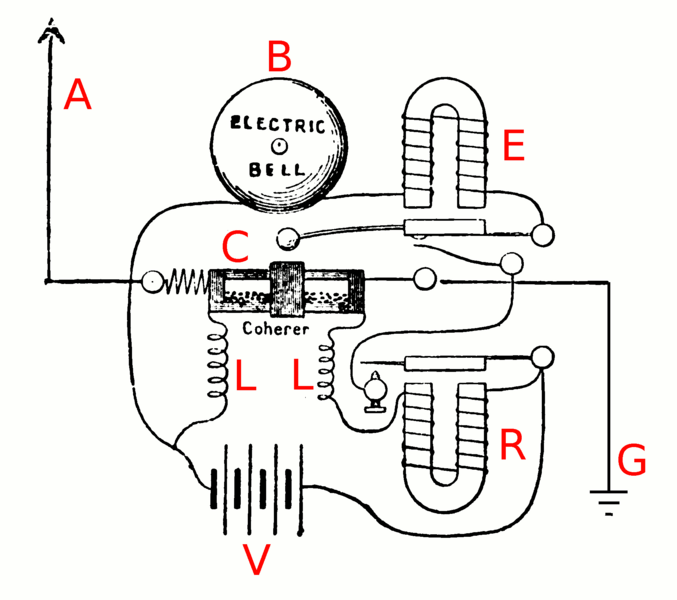Image: Popov receiver

Description: Pictorial diagram of the circuit of Alexander Stepanovich Popov's 1895 coherer receiver, one of the earliest radio receivers. Built as a lightning detector, to warn of approaching thunderstorms by detecting the radio pulses from lightning strikes, Popov first demonstrated it before the Russian Physics and Chemical Society in St. Petersburg 7 May 1895 by receiving transmissions from a spark gap transmitter. The device uses a primitive radio wave detector called a coherer (C), consisting of a glass tube containing metal filings between two electrodes. When radio waves are applied to the coherer electrodes it causes the coherer to become conductive. Before it can receive another signal, the metal filings must be mechanically disturbed by tapping the coherer, to restore it to the high-resistance receptive state. An advantage of Popov's receiver is that the coherer is automatically reset immediately after receiving a signal by tapping the glass tube with the arm of the electric bell used to indicate the arrival of the radio signal. The electrodes of the coherer are connected to a wire aerial (A) and a ground (earth) connection (G). The coherer electrodes are also connected in a second circuit to a battery (V) and a relay (R). When a radio signal from the antenna is applied across the electrodes, it causes the metal filings to become conductive. The current from the battery passes through the coherer and the relay's electromagnet, closing its contacts. This applies current to the bell's electromagnet (E), which pulls it's springy arm over to tap the bell (B). When the arm springs back it taps the coherer, resetting it. The relay is needed because the coherer won't pass enough current to ring the bell by itself. The chokes (L) prevent the impulsive radio noise from the relay's contacts from triggering the coherer again. Alterations to image: added ground symbol, labeled parts in red.
Title: Popov receiver
Credit: Retrieved 9 November 2013 from John Joseph Fahie 1902 A History of Wireless Telegraphy, Dodd, Mead, and Co., New York, p. 205, fig. 35 on Google Books
Author: Alexandr Stepanovich Popov
Usage Terms: Public domain
License: Public domain
Attribution Required?: No
Image usage
The following 2 pages link to this image:

